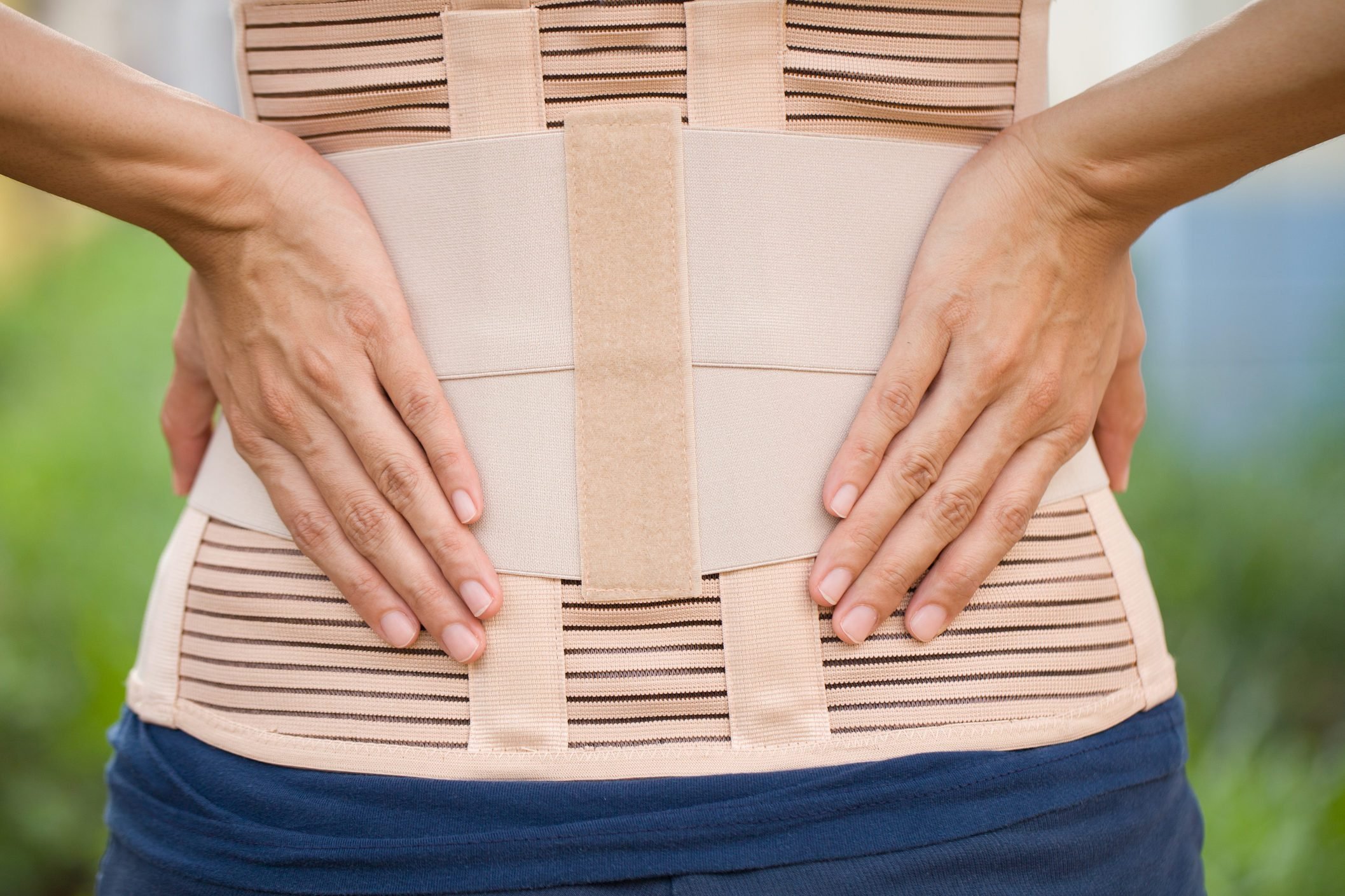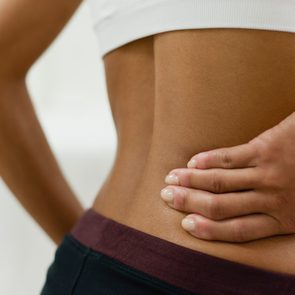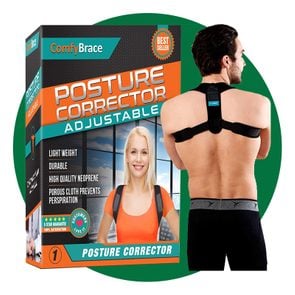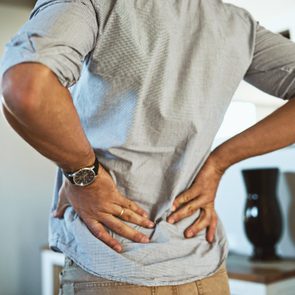Should You Try a Back Brace for Lower Back Pain?
Updated: Jun. 01, 2021
Lifestyle changes often help alleviate lower back pain, but can a back brace stop the discomfort and aches? Here's what the experts say.
Back braces for lower back pain
If you’ve ever dealt with back pain, the appeal of a back brace is understandable: A device available at your local drugstore that can ease your suffering? Plenty of people would sign up, given that lower back pain is the leading cause of disability worldwide, according to a 2020 study in Annals of Translational Medicine. Chronic back pain—symptoms persist for longer than three months—strikes 13 percent of adults and a third of them experience moderate- to high-level chronic pain, according to a recent JAMA study.
But can a back brace really solve lower back pain? It helps to have a good understanding of the common causes of back pain and how to prevent and treat it.
Common causes of lower back pain
Numerous conditions can lead to back pain, so it’s important to figure out the specific issue behind your aches. That’s where a medical professional comes in.
A doctor will discuss your health history and do a physical exam. “They’ll help you determine what muscles are weak and tight,” says Houman Danesh, MD, director of integrative pain management at Mount Sinai Hospital in New York City. The process will also help identify any underlying conditions or causes for pain. These are some of the potential sources of trouble:
Arthritis
Generally found in older populations (but also occurring in those with conditions like scoliosis), is a deterioration of the cartilage in the joints of the spine, says Akhil Chhatre, MD, director of spine rehabilitation and assistant professor in the Departments of Physical Medicine and Rehabilitation and Neurosurgery at Johns Hopkins University.
Osteoarthritis, which comes from wear and tear of the cartilage of the joints, is the most common form of arthritis, affecting 27 million adults in the United States. An estimated 40 percent to 85 percent of those have osteoarthritis of the lumbar (lower) spine, according to a study in Current Rheumatology Reports. In spinal osteoarthritis, cartilage breakdown happens at the facet joints, causing irritation and pain.
Other arthritis-related conditions that can cause back pain include spondyloarthritis (also known as spondylitis), which is inflammation of the joints of the spine and the sacroiliac joint that connects your pelvis and lower spine. It can cause pain and severe stiffness. Psoriatic arthritis is another type of arthritis that can cause back pain.
(Here are home remedies for arthritis from doctors.)
Facet syndrome
The joints in the lower back are known as facet joints. If they rub against one another—such as in the case of osteoarthritis of the facet joints—they can cause inflammation and pain, Dr. Danesh says.
You might feel worse pain first thing in the morning, when leaning backward, or when you go from sitting to standing. The pain often gets progressively worse over time.
“As you get older, your pain-free intervals decrease and you experience pain more often,” Dr. Danesh explains. Those prone to falls, new or expectant mothers, and those living a sedentary lifestyle all have increased risk of facet joint pain.
The condition is often treated with anti-inflammatory medications and/or physical therapy. A doctor may recommend steroid injections to relieve pain. Surgery may be needed in severe cases.
Spinal stenosis
Spinal stenosis is the narrowing of the spinal canal, which can put pressure on the nerves of the spine. A chronic and progressive issue—often a byproduct of arthritis—spinal stenosis can come with mild, moderate, or severe pain. This often gets worse with activity, like walking, says Dr. Chhatre.
Other symptoms of spinal stenosis include weakness in your legs or foot and numbness or tingling in your butt or legs.
Your doctor will diagnose the condition after a physical exam and, often, imaging tests such as an X-ray or MRI. People with spinal stenosis typically require a physical therapist to help manage symptoms.
Herniated disc
If your pain worsens while sitting or leaning forward, or if you experience dull aches that linger, you could have a herniated disc.
Discs sit between the vertebrae in your spine to absorb shock. When you herniate a disc, it pushes it outward. “It’s like a jelly doughnut exploding,” Dr. Danesh says. “That leads to a variety of issues, as the jelly can irritate the nerves and joints around it.”
If the dislodged disc hits the sciatic nerve in your back, you may feel a tinging sensation or shooting pain down the hip and leg, a condition known as sciatica.
Bending over to lift something heavy or twisting may cause a herniated disc, says Dr. Chhatre.
(These are the silent signs of a slipped disc.)
Muscle strain
The muscles of the low back, especially a deep abdominal muscle on either side of the lower spine called the quadratus lumborum, can get irritated and lead to pain in the low back, Dr. Danesh says. You might feel this off to the side and toward the hips. New activities are a common culprit. A person who tries skiing for the first time, for instance, might strain the muscles of the low back, leading to pain in this area.
Resting and icing the muscles are good first-line treatments. Physical therapy can help you strengthen to lessen pain in the injured area and modify your movements to avoid future muscle strains.
(Try these home remedies for sore muscles.)
Trauma
Falling or experiencing blunt force to the body can lead to low back pain, too, especially if you fracture a bone of the vertebrae or pelvis, Dr. Danesh says. A traumatic event can also contribute to a muscle or tendon sprain.
Seeing a doctor to address injuries, like fractures, is key to recovery. After a physical exam, your health care provider will offer the best course of treatment, whether that’s rest or over-the-counter pain (OTC) medications. Depending on the causes of your pain, your doctor may recommend additional treatment.

Should you wear a brace for lower back pain?
Remarkably, there isn’t a lot of scientific evidence to support the use of back braces. A 2018 study published in Orthopedic Reviews found back braces reduced pain and improved ability to move with few side effects. But the study was small, and the paper’s authors noted more research was needed.
“The idea of supporting the lower back is a phenomenal idea, and the body has a natural back brace, called the transverse abdominis [the TVA muscle], which looks like a back brace internally,” Dr. Danesh says. “If you use a back brace, that muscle that nature has designed is going to get weaker and weaker.”
And that raises the potential issue with using a back brace: The more you wear it, the weaker your TVA will get. Without a back brace, your core can do its job—stabilizing your back.
When should you consider a back brace?
Don’t rule out the devices entirely—there are some cases where a back brace may be helpful, Dr. Danesh says, including after surgery when you’re waiting for the body to heal.
In a study in The New England Journal of Medicine, back braces were helpful for adolescents with scoliosis, which is a curve of the spine.
Before you opt to wear a back brace, consult with your doctor to determine whether you’ll benefit from wearing it. Bonus: Your doctor can give you a better idea of the type of brace you need and for how long you should wear it.
(Here are the best products for easing lower back pain.)
How to wear a back brace correctly
If you’re aiming to address your chronic low back pain with a brace, Dr. Danesh suggests wearing it for no more than 30 to 40 minutes at a time, and only during movements that might require work, like standing to do the dishes, working construction, or weight lifting. This might be beneficial for those who aren’t finding relief from other interventions and simply need to relieve pain as they do daily activities.
Don’t go overboard, though. “Prolonged use of a back brace, over weeks or months, I wouldn’t recommend,” Dr. Danesh says.
How to manage lower back pain
If you’re not using a back brace (or even if you are) how can you keep back pain in check? Try these tips.
Maintain core strength
For starters, make sure you have solid core strength.
“You want the muscles that stabilize the lower back to be strong, and those muscles include the gluteus muscles [located in the buttocks],” Dr. Danesh says.
Prolonged sitting—a hazard of most office jobs—can have a negative effect on the muscles that stabilize the back. When you take a walk after eight to 10 hours of sitting without standing breaks, those muscles may feel the strain. Plus, all that sitting makes for tight hip flexors, which pulls the pelvis in a way that loads the lower back.
Stay active
If you have lower back pain, staying physically active through regular exercise can help. You can start with a walking plan and then ease your way into exercises and stretches for your lower back pain (see below). However, consult with your doctor before you engage in exercises to avoid exacerbating your back pain.
Strengthening exercises
Dr. Danesh suggests glute-strengthening exercises like glute bridges. He also recommends stretching the quads and iliopsoas (hip flexor muscles). Doing lunges and yoga, including cobra pose and cat-cow, will help.
(Try these exercises for lower back pain.)
Hydrate
Dr. Danesh recommends drinking plenty of water. “This will get you up to go to the bathroom and keep you hydrated,” he says. “Hydration is really important for your muscles.”
Good posture
Maintaining good posture is important to relieve pressure on your lower back. Poor posture can strain your back and lead to further pain. Here are some tips for improving your posture—and lessening your back pain.
(Improve your posture with these posture correctors recommended by back experts.)
Good shoes
A good pair of shoes can help prevent or alleviate lower back pain. Cushioning soles are key for those with a foot dysfunction or imbalance—they’ll absorb the shock when your heel touches the ground, instead of your lower back. (These are the best walking shoes for your feet.)
Mattress support
Lower back pain is associated with poor sleep. An old mattress, or one that doesn’t offer much support, can lead to both sleepless nights and back pain. Therefore, it’s important that your mattress can offer additional lumbar support. (Check out the best mattress for lower back pain.)
Ice and heat
Both ice and heat can help reduce lower back pain. The key is to first ice a new injury, then heat.
Ice works, similar to a local anesthetic, numbing the sore muscle. Meanwhile, heat application to the area boosts circulation in the body, reducing inflammation and repairing damaged muscles.
Don’t apply an ice or heat source directly onto the skin. Wrap an ice pack in a cloth to prevent skin injury. And use a heat pack or heating pad wrapped in a cloth to avoid burning your skin.
OTC medications
Nonsteroidal anti-inflammatory drugs (NSAIDs) and over-the-counter (OTC) pain relievers, like ibuprofen (Advil) and acetaminophen (Tylenol), can also help to manage low back pain.
Physical therapy
A physical therapist can help you address weaknesses and imbalances, and build strength and flexibility where needed. (These are the secrets physical therapists know about you.)
The last word
Most back pain gets better in four to six weeks, Dr. Danesh says. If your pain lasts longer, head to your doctor. Also, if you’re miserable and have trouble doing daily activities before those four to six weeks are up, it’s also a good idea to see a medical provider.
Remember, if you’re thinking about wearing a back brace, consult with your doctor to determine if it’s the best course of treatment for your back pain. Other treatment options, like OTC medications or physical therapy, may be more effective for your specific back pain.
Next, here’s how your brain helps with lower back pain.






















